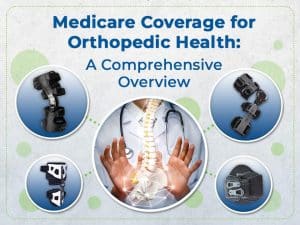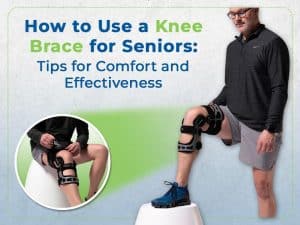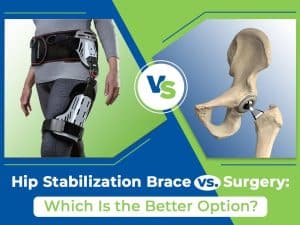Our bodies become more susceptible to injuries and chronic pain as we age. In particular, the knees can be particularly vulnerable to these issues, and seniors may experience a wide range of knee problems, such as osteoarthritis, tendonitis, and other types of joint pain. These issues can significantly impact mobility, making it difficult to perform everyday activities or even stay active. Knee braces have become an increasingly popular solution for seniors who want to prevent or manage these knee problems. In this article, we will discuss the benefits of using knee braces, how they work, and what to consider when choosing the right knee brace.
Why are Knee Braces Important for Seniors?
Knee braces are beneficial for seniors because they provide additional support and protection to the knee joint. As we age, our bones and muscles become weaker and more susceptible to injury. Knee braces help to prevent or reduce the severity of injuries by providing stability to the joint. They can also help to reduce pain and inflammation caused by arthritis or other conditions that affect the knee.
Another reason why knee braces are important for seniors is that they can improve mobility and balance. Knee problems can affect how we walk, stand, and move, increasing the risk of falls and other accidents. A knee brace can help seniors to maintain proper alignment and reduce the risk of losing balance or tripping.
Types of Knee Braces for Seniors
Several knee braces are available, and the type that is best for a senior will depend on their specific needs and condition. Here are some of the most common types of knee braces:
- Prophylactic knee braces: These braces are designed to prevent injuries by providing additional support and stability to the knee. They are typically worn during physical activities and sports.
- Functional knee braces: These braces are designed to provide support to the knee following an injury, such as a sprain or tear. They are typically prescribed by a doctor or physical therapist and used during rehabilitation.
- Unloader/offloader knee braces: These braces are designed for seniors who have arthritis or other conditions that cause pain in the knee joint. They work by shifting the weight away from the affected area, which can reduce pain and inflammation.
- Hinged knee braces: These braces provide additional support and stability to the knee joint by using hinges that allow limited movement. They are typically used following an injury or surgery.
Benefits of Using Knee Braces for Seniors
Seniors can benefit greatly from knee braces, which can help prevent injuries and improve performance. Here are some of the key benefits:
- Injury Prevention: Knee braces can help prevent injuries by providing additional support and stability to the knee joint. This is especially important for seniors who are more susceptible to injuries.
- Pain Relief: Knee braces can help reduce pain and inflammation caused by arthritis or other conditions that affect the knee. This can improve overall comfort and quality of life.
- Improved Mobility: Knee braces can help seniors maintain proper alignment and reduce the risk of losing balance or tripping. This can improve mobility and increase independence.
- Faster Recovery: Knee braces can help seniors recover faster from injuries or surgeries by providing additional support and stability to the knee joint during the healing process.
Read More: Knee Braces: Improve Performance and Preventing Injury for Seniors
How to Choose the Right Knee Brace for Seniors?
When choosing a knee brace for a senior, it is important to consider the type of brace and the needed level of support. Here are some tips for choosing the right knee brace:
1. Consult a doctor or physical therapist
They can recommend the type of brace best suited for the senior’s needs and condition.
2. Consider the level of support
The level of support needed will depend on the severity of the knee problem. A prophylactic knee brace provides less support than a functional or unloader/offloader brace.
3. Consider the fit
The brace should fit comfortably and securely without restricting movement or causing discomfort.
4. Consider the material
Knee braces can be made from a variety of materials, including neoprene, elastic, and metal. Consider the material when selecting a knee brace, as some materials may be more comfortable or suitable for your needs than others. For example, neoprene knee braces are popular because they provide compression and heat retention, which can help reduce pain and swelling. However, some people may be allergic to neoprene or find it uncomfortable to wear for long periods of time.
Elastic knee braces are lightweight and breathable, making them a good option for active seniors who need a brace that won’t weigh them down. They are also easy to put on and take off, which can be important for seniors who may have limited mobility.
Metal knee braces are the most supportive and can provide the most stability to the joint. However, they can also be heavy and uncomfortable to wear for extended periods of time. They are typically reserved for more serious injuries or conditions that require the highest level of support.
5. Fit
It is important to select a knee brace that fits properly and comfortably. A brace that is too tight can restrict movement and cause discomfort, while a brace that is too loose may not provide the necessary support. Measuring your knee before selecting a brace and following the manufacturer’s sizing guidelines is recommended.
6. Brand
Choose a reputable brand when selecting a knee brace. Look for reviews and recommendations from other individuals who have used the same type of brace. This can help you make an informed decision and ensure that you are getting a high-quality product.
How to Wear a Knee Brace?
Wearing your knee brace properly is important to ensure it provides the necessary support and protection to your joint. Follow the instructions provided with your knee brace to ensure you are wearing it correctly. Adjust the straps or hinges to ensure a comfortable and secure fit. Wear your knee brace during physical activities as your doctor or physical therapist recommends.
In Conclusion
Knee braces can be valuable for seniors who want to avoid injury and perform better. When selecting a knee brace, it is important to consider the level of support, type of brace, material, fit, and brand. By wearing your knee brace properly and following your doctor or physical therapist’s recommendations, you can experience the many benefits of using a knee brace as a senior.
Our knee braces are universal in size and feature multiple range-of-motion positions to offer support and comfort to restore mobility. If you’re unsure what product is right for you or if you’re eligible for insurance coverage, Artik Medical Supply will provide the guidance you need. We can even communicate with your doctor to determine the best knee orthopedic brace for you. Contact us today to check for insurance coverage.
Article Key Phrases
- Knee brace benefits for seniors.
- How knee braces can prevent injury in seniors.
- Knee brace types for seniors.
- Knee brace fit for seniors.
- Knee brace recommendations for seniors.










